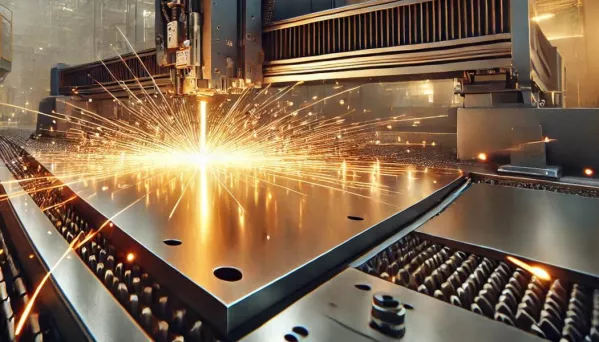+48 95 762 08 61
Modern technologies of metal working
Laser beam cutting
Laser cutting of tubes and sections
Robotic welding
Sheet metal bending
Laser beam cutting
Laser cutting of tubes and sections
Robotic welding
Sheet metal bending

In material processing, laser cutting is one of the most precise and efficient technological processes. However, achieving optimal cutting quality requires a thorough understanding and control of numerous process parameters. Each of these parameters can significantly impact the final result, and their interactions create a complex system of dependencies.
The power of the laser beam is a fundamental parameter in the cutting process. Its selection must consider the type and thickness of the material being cut. Insufficient power can result in incomplete material cutting or slag formation, while excessive power may cause over-melting and deterioration of edge quality. Real-time power stability is particularly crucial, as even short-term fluctuations can lead to inconsistencies in cutting quality.
The cutting head's feed speed is closely linked to the laser power and material thickness. At too high a speed, the energy delivered to the material may be insufficient for complete cutting. Conversely, too low a speed may lead to excessive material heating and a broader heat-affected zone. The optimal feed speed should ensure complete material cutting while maintaining a minimal kerf width.
The distance between the nozzle and the material surface is often underestimated, yet it significantly impacts cutting quality. Proper nozzle positioning affects the characteristics of the assist gas stream and the focus of the laser beam. A distance that is too small may damage the nozzle and disrupt gas flow, while a distance that is too large reduces cutting efficiency.
Assist gas serves multiple functions in the laser cutting process. It removes molten material from the kerf, protects the optical system, and can support the cutting process through exothermic reactions (e.g., with oxygen). Gas pressure must be carefully adjusted—too low, and it will not effectively remove material; too high, and it may cause turbulence and irregularities in the kerf.
Different materials require distinct approaches to parameter optimization. Stainless steel, aluminum, and titanium each have unique physical and chemical properties, necessitating specific parameter sets. For example, cutting aluminum requires higher laser power due to its high reflectivity and thermal conductivity.
Modern laser cutting systems increasingly employ advanced monitoring and control systems. Real-time sensors track parameters such as temperature in the cutting zone, beam stability, and cut surface quality. This enables dynamic parameter adjustments to maintain optimal cutting quality.
Optimizing cutting parameters directly affects the economic aspects of the process. Proper parameter selection can significantly reduce energy and assist gas consumption while extending the lifespan of consumable components. Additionally, minimizing defective parts and downtime improves production efficiency.
Contemporary trends in laser cutting process optimization focus on leveraging artificial intelligence and machine learning for automatic parameter selection. These systems, based on vast historical data sets, can predict optimal settings for various materials and cutting conditions.